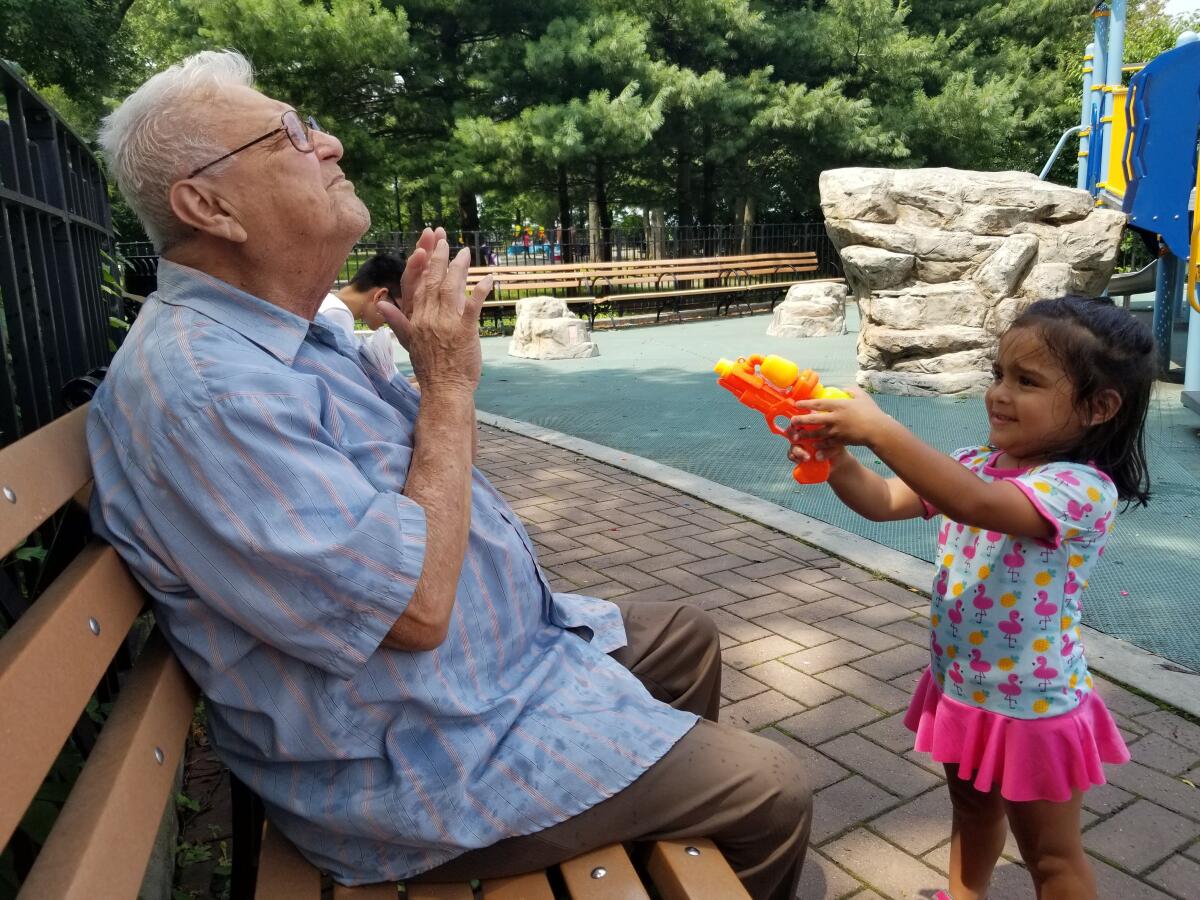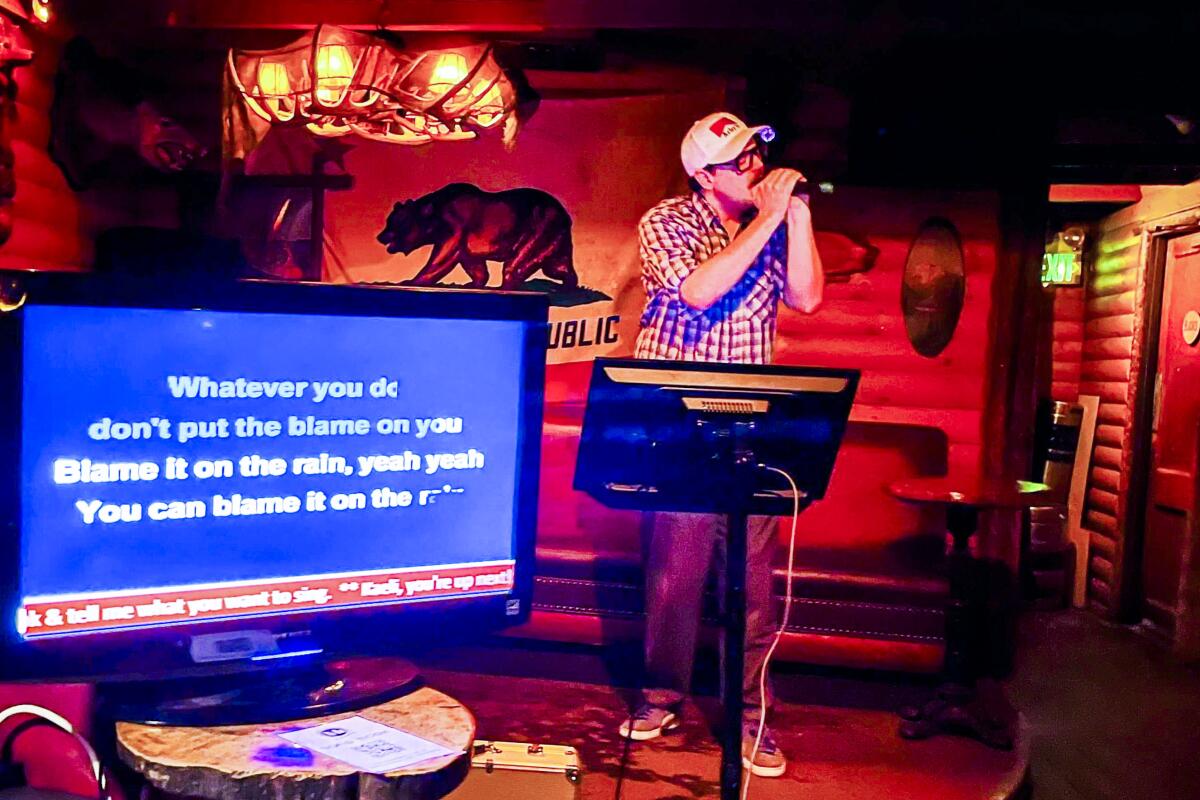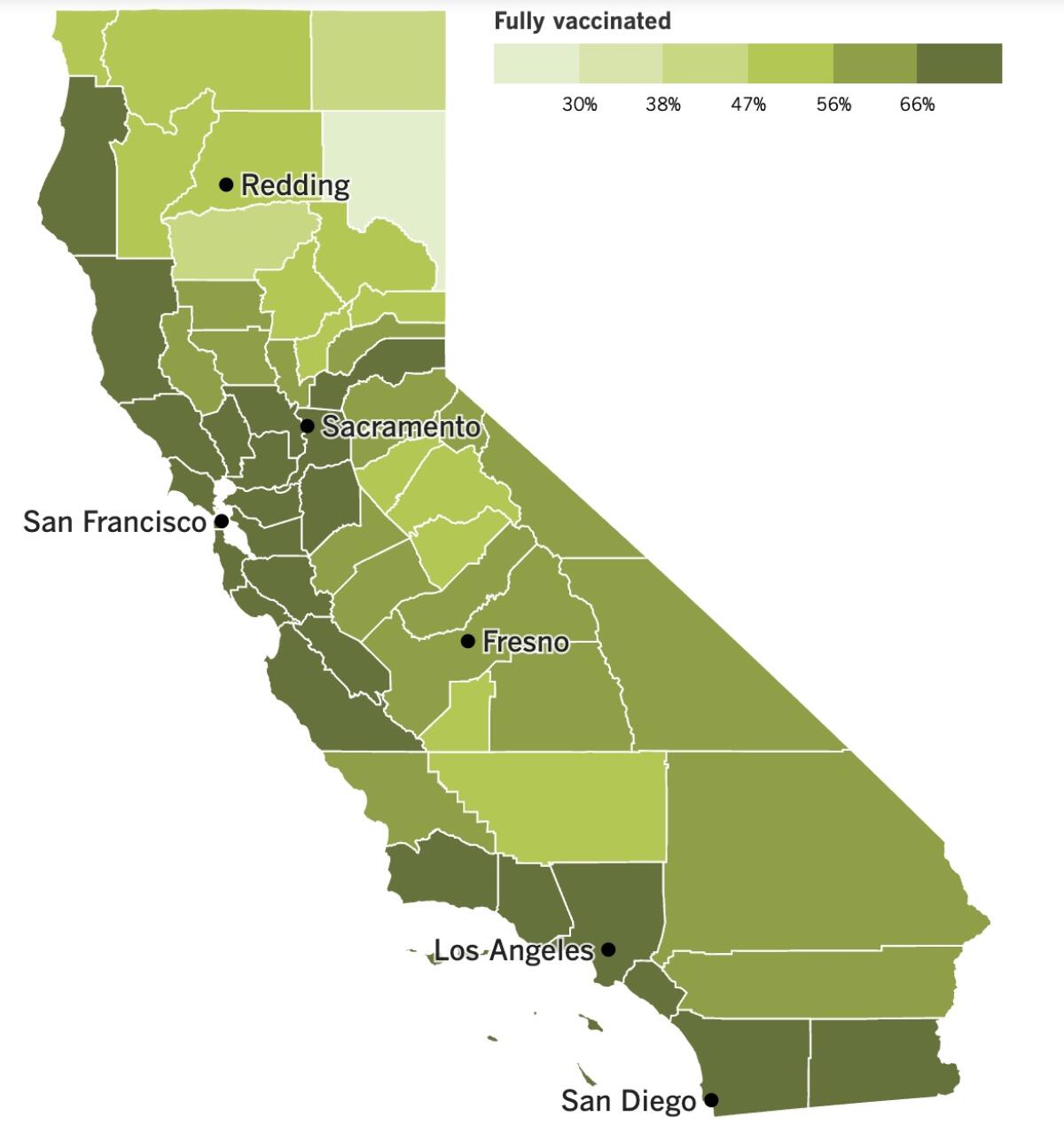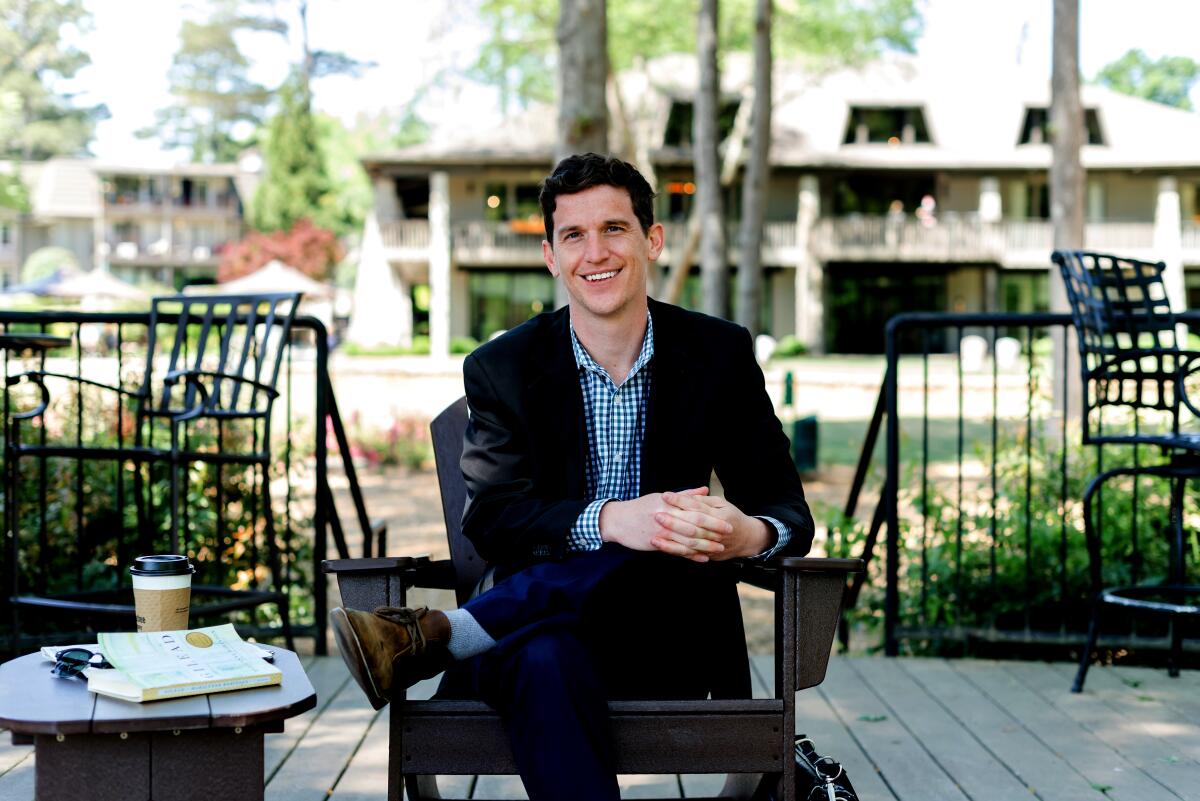Coronavirus Today: Feeling the loss of Latino grandparents
- Share via
Good evening. I’m Karen Kaplan, and it’s Tuesday, Nov. 29. I hope you had a relaxing and COVID-free Thanksgiving break. Now here’s the latest on what’s happening with the coronavirus in California and beyond.
By day, 65-year-old Reynaldo Rosales worked at a distribution center for health supplements in Santa Cruz County. His paychecks helped pay the rent for himself and his wife, Maria, along with two of their adult sons.
During evenings and weekends, Reynaldo and Maria babysat their grandchildren, allowing the kids’ parents to spend more time earning money.
Reynaldo came down with COVID-19 in January 2021, the deadliest month of the pandemic. He didn’t make it, leaving behind multiple holes in the fabric of his family.
Maria now watches the grandchildren alone. But she can’t babysit as much as she used to because, without her husband’s income, she needs to spend more hours working for pay. That means her children have to cut back their work hours or shell out for a sitter.
Across the country, families like the Rosaleses are grieving the loss of grandparents who held their clans together not just emotionally but also financially.
Without them, the Latino community’s rising prosperity may be in jeopardy, my colleague Don Lee reports.
Older Latinos have been helping their families get ahead for years. They’re more likely to put off retirement, data from the federal Bureau of Labor Statistics suggests. And when they’re not working, they’re often enabling others to do so by providing childcare, driving carpools, preparing meals and helping with homework.
That’s easier to do when living in a multi-generational household, another Latino advantage. In the U.S., Latino children are 25% more likely than children as a whole to live with a grandparent, according to data from the Census Bureau.
Leave it to the pandemic to turn these advantages into disadvantages.
Age is the biggest risk factor for developing a serious or fatal case of COVID-19 (though that risk can be mitigated with vaccines). But instead of isolating themselves, hands-on grandparents increase their exposure to the coronavirus.
Working outside the home is another great way to encounter the coronavirus, and Latinos have held down a disproportionate share of essential jobs since the earliest days of the pandemic.
Factors like these help explain why Latinos have suffered more COVID-19 deaths per 100,000 people than most other racial and ethnic groups for most of the pandemic. (The group classified as American Indians or Alaska Natives has had the highest COVID-19 mortality rate.) Among adults 55 and up in particular, the odds of dying of COVID-19 are higher for Latinos than for white, Black and Asian Americans, according to the Centers for Disease Control and Prevention.
There’s an extra dimension to the premature loss of a Latino grandparent, said Arturo Bustamante, a professor of health policy and management at UCLA who has been studying the pandemic’s effects on Latinos. Such deaths can make “it difficult for households to keep making progress,” he said. “Now COVID is another factor that threatens economic security.”

The loved ones of Tobias Noboa can attest to that.
After he retired as a taxi driver in Queens, N.Y., he kept his four-generation household running by “driving, cooking, taking care of the kids,” said his adult granddaughter Shyvonne Noboa. Tobias was also instrumental in caring for his bedridden wife, Juana, changing her diapers and giving her insulin shots.
Family members believe Tobias contracted the coronavirus from the great-grandchildren he played with daily. He died weeks later at the age of 82.
Now Shyvonne’s mother, Janet, will be giving up her job as a hospital concierge to care for Juana. Shyvonne, her boyfriend and their two children moved to a new apartment because it was too painful to stay in the home where memories of Tobias abound.
“My grandpa was energetic, active and brought such warmth and love to our lives,” Shyvonne told Lee. COVID, she said, “took all that away.”
By the numbers
California cases and deaths as of 2:35 p.m. on Nov. 29:

Track California’s coronavirus spread and vaccination efforts — including the latest numbers and how they break down — with our graphics.
Singing our COVID blues away
With Thanksgiving still fresh on our minds, it’s a good time to pause and appreciate the things we’re grateful for. That list might include karaoke.
It’s not an activity that was guaranteed to survive the pandemic. You may recall that illnesses and deaths among people who participated in group singing helped scientists realize the coronavirus could spread through the air. (The Centers for Disease Control and Prevention now recognizes airborne transmission as one of the primary ways the virus circulates from person to person.)
That’s not the only thing karaoke has going against it. It’s conducted indoors, often in small rooms. If singers are lucky, they’ll be performing to a large crowd. Add alcohol to the mix and the risk rises further, thanks to a combination of biological and social factors.
Factors like these explain why karaoke clubs across Los Angeles were empty in the pandemic’s worst days. Singing is back now, but with a decidedly different vibe, my colleague August Brown reports.
“Pre-COVID and after, it’s a huge difference,” said Sun Kim, who manages Rosen Karaoke in Koreatown. “There are fewer big groups or corporate events. Now people usually hang out with who they came with.”
He’s not the only one who’s noticed a change.
“It’s completely different now,” said Steven Spear, proprietor of Boardwalk 11 in Palms. Since Omicron’s arrival, “crowds have been 60[%], 70% at most.”
You could say that’s the glass-half-empty viewpoint. If you’re more of a glass-half-full kind of person, you might marvel that karaoke bars are open at all.
“It’s crazy that karaoke survived a year of lockdown,” said Thom Sigsby of Hi Ho Karaoke, a roving DJ who makes amateur singing possible at bars around L.A.

Coronavirus activity has been on the rise in L.A. County, but no one expects health authorities to respond by ordering restaurants, bars and clubs to shut down. That puts the onus on singers to decide for themselves what they’re willing to do to reduce their risk.
At a minimum, you should be fully vaccinated and get a dose of the new Omicron-targeting booster shot before hitting up a karaoke bar, advises Melanie D. Sabado-Liwag, a professor of public health at Cal State Los Angeles. But that won’t be enough to guarantee you’re protected against the highly infectious Omicron strains, she said, so masking up indoors is probably a good idea — even if that means belting out “Since U Been Gone” through a layer of polypropylene.
“Boosters help, masks help, airflow helps,” she said. “There’s a layering effect people have to be mindful of if they’re going out.”
For the sake of those around you, Sabado-Liwag also suggests vigilant testing after your night out. That way, if you do catch the coronavirus, you can quickly isolate yourself and start taking Paxlovid “so we can break the chain” of transmission, she said.
Inconveniences like taking a few extra coronavirus tests are a small price to pay to enjoy karaoke in the midst of a pandemic. At Formosa Cafe in West Hollywood, most customers not only followed rules about COVID-19 vaccines and face masks but also seemed to appreciate the sentiment behind them.
Karaoke is meant to be a “safe place,” said Matt Wise, the club’s general manager. If you have to wear a mask while you sing, he added, that’s not the end of the world.
If you’re ready to get back in front of a microphone, check out our list of 29 essential spots for every kind of karaoke singer and our ultimate guide to finding your go-to karaoke songs.
California’s vaccination progress

See the latest on California’s vaccination progress with our tracker.
Your support helps us deliver the news that matters most.
In other news ...
Los Angeles County — and most of the rest of California — still has a low COVID-19 Community Level, according to the CDC. But with nearly 140 new cases per 100,000 residents per week, county health officials have reinstated their strong recommendation for wearing face masks in indoor public spaces.
“Indoor masking is, as it has been in the past during times of elevated transmission, strongly recommended for all individuals,” said county health officer Dr. Muntu Davis.
More specifically, Davis and others would like to see people donning high-quality masks that fit closely to the face. In addition to wearing them inside businesses, restaurants, government offices and other places open to the public, people are advised to wear masks while taking public transportation; in detention and correctional facilities; and in emergency and homeless shelters.
Earlier this month, the county considered masking a matter of individual preference. But then coronavirus case rates began rising again. As of Tuesday, they’re up 52% over the last two weeks.
(As a reminder, masks are still required in L.A. County healthcare facilities and nursing homes. And if you’ve been exposed to COVID-19, you must mask up in public for 10 days, Davis said.)
Presuming that many people did not mask up over the Thanksgiving holiday weekend, we could see cases rise further in the coming weeks. In 2020 and 2021, holiday-fueled surges resulted in the two deadliest periods of the pandemic. But some health experts are optimistic that history won’t repeat itself in 2022.
Why not? The new booster shots are specifically designed to target an Omicron strain — albeit one past its prime; BA.5 currently accounts for about 19% of coronavirus specimens now circulating in the U.S., the CDC estimates — and there are more than enough doses available. Tests and medicines are abundant as well.
Even better: In some places where newer Omicron subvariants are pushing COVID-19 numbers higher, hospitalizations are not following suit. That was the case in New York state, which has the nation’s highest concentration of BQ.1.1 infections, and in Singapore, which weathered a surge powered by XBB.
“You never can definitively say what to expect,” said Dr. Anthony Fauci, who will be leaving his post at the National Institute for Allergy and Infectious Diseases next month. “But you should really take some comfort in knowing that we have within our wherewithal to mitigate anything that comes up our way.”
COVID-19 hospitalizations are increasing in California, however. At the latest count, there were 2,782 hospitalized patients throughout the Golden State, up 27% from the prior week. That’s still an order of magnitude below the all-time high of 21,938, set during the first pandemic winter.
Hospitalizations are also up among babies, especially among those too young to be vaccinated. Across the country, the number of infants under 6 months who were hospitalized with COVID-19 averaged 13.7 per 100,000 per week between Dec. 19 and Aug. 31, according to a new report published by the CDC.
Only senior citizens were more likely to be hospitalized with COVID-19 during that time period. Among adults 65 to 74, the average number of weekly hospitalizations was 13.8 per 100,000; among those 75 and up, it was 39.4 per 100,000.
Dr. Rochelle Walensky, the CDC director, said those numbers show that it’s important for pregnant people to get vaccinated and boosted so they can protect their newborns who aren’t yet eligible for the shots.
Another new report from the CDC offered evidence that the new Omicron-targeting boosters are indeed an improvement over the original vaccine formula. Researchers examined the vaccination records of people with COVID-like symptoms who got tested at drugstores around the country between September and early November. By comparing the records of those who did and didn’t test positive, they determined that people who got the new booster had greater protection than those who’d only had doses of the original vaccines.
The amount of added protection depended on several factors, including a person’s age, how many vaccine shots they’d had, and the length of time between them. At the low end, it was 28% for adults 65 and up who’d had a prior booster in the past two to three months. At the high end, it was 56% for adults 18 to 49 who had gone at least eight months since their last shot.
Pfizer and BioNTech also announced some promising news about their new booster. A study conducted by the companies and researchers from the University of Texas Medical Branch in Galveston found that although the shots were designed to target the BA.5 strain, they also generated antibodies capable of attacking other Omicron subvariants, including the worrisome BQ.1.1. Those data have yet to be vetted by independent experts.
Before we leave this topic, here’s one more piece of news: Ice Cube said he walked away from a $9-million movie deal because he wasn’t willing to get a COVID-19 vaccine. “I turned down $9 million because I didn’t want to get the jab,” the rapper and actor said on a podcast. “F— that jab and f— y’all for trying to make me get it.”
It’s getting more difficult to counteract misinformation and disinformation about the pandemic on social media. Under new owner Elon Musk, Twitter stopped enforcing its policy against COVID-19 misinformation on Nov. 23.
That means the company will no longer label tweets that contain false material about a disease that killed 2,644 Americans in the week before Thanksgiving. Nor will it remove such tweets or augment them with correct information, as it used to. The change appears to be part of Musk’s larger effort to facilitate “free speech” among the platform’s hundreds of millions of users.
And finally, those protests in China over the country’s stringent “zero COVID” policy have ratcheted up to new levels. The latest instigating event was a fire that broke out Thursday in an apartment building in the northwestern city of Urumqi, where lockdowns have kept some residents confined to their homes for four months. At least 10 people died in the blaze, raising questions about whether locked doors prevented victims from escaping.
Demonstrations began the next day and spread to cities around the country. Hundreds of protesters in Shanghai gathered on a street called Middle Urumqi Road. Some lighted memorial candles, and others called for Chinese President Xi Jinping to step down. Police responded with pepper spray.
In Beijing, about 200 demonstrators held up blank sheets of paper to draw attention to the Communist Party’s pervasive censorship. So did protesters at Chinese University in Hong Kong. The rallies, which also took place in Nanjing, Guangzhou, Chengdu and Chongqing, added up to the biggest public challenge to the Communist Party in decades.
Party officials insist the zero-COVID strategy is working. “Facts have fully proved that each version of the prevention and control plan has withstood the test of practice,” a commentator wrote in People’s Daily, the party’s mouthpiece.
Last week, China announced its first COVID-19 fatality in nearly six months. The victim was an 87-year-old man from Beijing, who became the country’s 5,227th official casualty of the pandemic (though the COVID-19 counters at Johns Hopkins University estimate the death toll is closer to 16,000).
Your questions answered
Today’s question comes from readers who want to know: How long do I need to air out my house if someone comes inside without wearing a mask?
You may find yourself wondering this if the technician who comes to fix your finicky Wi-Fi enters your home without a mask and you don’t want to risk losing your appointment by insisting on a face covering.
There’s no one-size-fits-all answer to this question, said Dr. Aaron E. Glatt, chief of infectious diseases at Mount Sinai South Nassau in Oceanside, N.Y.
“There are so many variables here,” he said. “How much viral load does that person have? How much are they coughing? How long since the onset of symptoms? Does this person have prior vaccination that would make them have a lower viral load? What is the temperature of the room? How much is the wind blowing in from open window? What’s the size of the room?”
The key to ensuring your safety is to make sure all the air in the affected parts of the house has been replaced, said Dr. Luis Ostrosky, chief of infectious diseases at UTHealth Houston and Memorial Hermann Hospital.
“A complete changeover of air in a room is going to take about an hour to four hours, depending on the efficiency of the HVAC system,” Ostrosky said. That time can be reduced to almost nothing by opening lots of windows, he added: “The more fresh air you get in the mix, the faster it clears.”
Ostrosky and Glatt agreed that five minutes ought to be enough time to air out a room with open windows. But Glatt noted that if there’s someone in the household who’s at high risk of becoming severely ill, “maybe I wouldn’t have the repair person in the house in the first place.”
We want to hear from you. Email us your coronavirus questions, and we’ll do our best to answer them. Wondering if your question’s already been answered? Check out our archive here.
The pandemic in pictures

The man in the photo above is Ryan Prior, author of a new book called “The Long Haul.” It’s about the millions of people whose COVID-19 symptoms linger for months, if not longer.
Surveys by the CDC suggest roughly 1 in 7 U.S. adults have contended with long COVID at some point during the pandemic. Yet despite that high prevalence, the syndrome — which can manifest with a perplexing mix of symptoms — is still poorly understood.
To the extent that progress has been made, it’s long haulers themselves who deserve much of the credit. In his book, Prior recounts how patient-activists joined forces and persuaded the medical establishment to take their ailments seriously. They were also instrumental in collecting valuable data about the disease, acting as citizen scientists. No less an authority than the director-general of the World Health Organization gave the patients props for essentially “writing the first textbook on long COVID.”
Prior doesn’t have long COVID himself, but he has a similar ailment called myalgic encephalomyelitis, or chronic fatigue syndrome. That gives him a unique perspective on what COVID long haulers have been through, Sheana Ochoa writes in a review of Prior’s book.
“Perhaps the truest hope I know,” Prior wrote, “is a faith in the resilience of regular people with lived experience of a problem to gather together ... to try and change the world.”
Resources
Need a vaccine? Here’s where to go: City of Los Angeles | Los Angeles County | Kern County | Orange County | Riverside County | San Bernardino County | San Diego County | San Luis Obispo County | Santa Barbara County | Ventura County
Practice social distancing using these tips, and wear a mask or two.
Watch for symptoms such as fever, cough, shortness of breath, chills, shaking with chills, muscle pain, headache, sore throat and loss of taste or smell. Here’s what to look for and when.
Need to get a test? Testing in California is free, and you can find a site online or call (833) 422-4255.
Americans are hurting in various ways. We have advice for helping kids cope, as well as resources for people experiencing domestic abuse.
We’ve answered hundreds of readers’ questions. Explore them in our archive here.
For our most up-to-date coverage, visit our homepage and our Health section, get our breaking news alerts, and follow us on Twitter and Instagram.




